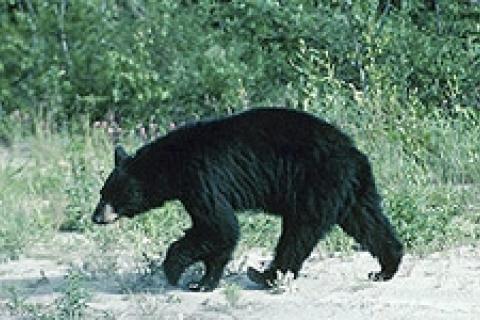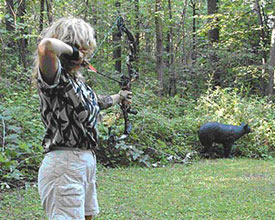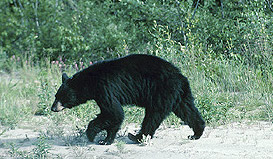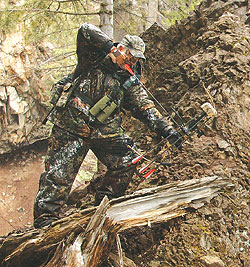
While technically easy to prepare for, my first black bear bowhunt proved to be more of a lesson in black bear research than I imagined. Here are some basic pointers to help you prepare for your first bow hunt for black bear.
I'd desperately longed to hunt black bear for over two years. I'd bowhunted whitetails for many years, yet somehow I imagined embarking on a black bear bow hunt was significantly more difficult and more dangerous. As a woman bowhunter, I knew no other women locally that hunted bear. But as my acquaintances in the hunting industry broadened and I traveled to hunt camps in other states, my interest in hunting black bears increased substantially as did my knowledge of exactly what a black bear bow hunt entailed. Turns out, as a seasoned bowhunter, preparing for my first black bear bow hunt was much easier than I'd imagined, but it required much more reading and studying than I'd expected. What resulted was pure black bear hunting addiction!
As with most hunts, this hunt required steady nerves and excellent shooting skills first and foremost; but I found several additional ingredients necessary before embarking on my first black bear hunt:
- Keen awareness of your own shooting ability and your bow's kinetic energy (distances achievable with adequate poundage pulled for good penetration and a successful kill shot)
- Thorough understanding of the location of a bear's vitals and optimal shot placement from different angles
- Ability to correctly access and judge bear size and age
- General knowledge about bear behavior, primarily feeding behavior and common bait site behavior
- General knowledge about sow and cub behavior, primarily for safety's sake
- Excellent scent control
- Excellent bug suit and head net protection
- Ability to remain on stand and motionless for hours
Hunting Equipment
 |
| Best practice advice: purchase a 3-D bear target or two and shoot regularly with it. |
I discovered that basically the equipment I used for whitetail was sufficient for bear. While this may not always be the case, I found my 60-pound pull weight on my Outback bow and my 3-bladed 100-grain Muzzy broadhead (1 3/16-inch cutting diameter) very sufficient to take down a nice bear with a well-placed shot up to 40 yards. A lighter weight bow is of course possible, but hunters must consider the kinetic energy of their bow, the shot distance and resulting penetration before executing any shot; especially at a mature black bear. Any seasoned hunter should be able to prepare easily for bear hunting, with possible minor alterations in bow set-up, poundage and type of broadhead used. The main factor to consider is the "well-placed" shot. A lighter weight bow can be just as effective as a heavier poundage bow, depending on the proximity of the bear and the shot executed. Regardless of the bow weight, bear hunting 101: focus on studying bear anatomy, know your own bow's effective killing power, and acknowledge its (and your) limitations. Best practice advice: purchase a 3_D bear target or two and shoot regularly with it.
 How to Identify Size & Age of a Bear
How to Identify Size & Age of a Bear
As a beginner bear hunter, I found the most difficult task was learning to identify the size (weight) and age of a bear. If a hunter doesn't live in an area frequented by black bears, it is an uncommon sight and a task that takes some time and experience to correctly access the weight and age of a mature bear. If your bear hunts are a year apart, that doesn't leave the hunter with much time for practice judging bears on a regular basis. Requesting a guide sit with you in the tree may be preferred for beginner bear hunters, but eventually you'll likely wish to hunt on your own. Though it may sound silly, a visit to the local zoo may be in order for observing bear and learning how to better judge their size. Watching bear hunting videos is another great aid.
Other variables to observe: When it stands broadside, does its belly hang low or not, does its legs and body look lanky or stocky? Is its face pointed and more dog-like (young) or more square (mature)? Is its fur extremely puffy and furry (younger) or does the bear sport a beautiful black coat? Do its ears look large in comparison to its head (young), or do its ears look small, spaced further apart, and its head large and round like a basketball?
Is the bear pear-shaped (more typical of a female bear, with thinner shoulders and a wider rear-end) or is it more squared (male) and does it swagger like a bow-legged cowboy? Lone bears are typically boars, and a bear accompanied by smaller bears, a sow with cubs.
These are just some ideas on how to judge size and I.D. the bear you're watching, but the best judging comes from experience and spending time a field studying and hunting bears.
Learn About a Bears Vitals
To learn all I could about a bear's vitals, I consulted magazines, books and the internet. I sought out bear anatomy and organ illustrations and committed them to memory, noting that the heart lies further forward in a bear's chest than in a whitetails.' I also noted the lung location, with vitals being located a little higher than a whitetails, and made a mental note to keep in mind how misleading a bear's body outline can appear when masked with a bounty of black, puffy fur. Several inches of their thick coat can make pin alignment on its kill zone unnerving, making it imperative to consider that factor before releasing an arrow. As with whitetails, I consider the best shot scenario to be a quartering away shot. However, one should practice and consider shot placement from many angles; perfectly broadside, standing/sitting upright looking at you, standing/sitting upright with it's back to you, and quartering toward you. While some hunters proclaim a head-on shot possible with a bow (shooting into the lower neck), I think it would be best to pass and wait for another opportunity before risking that low-percentage shot.
Practice shooting while both standing and sitting on the ground, in a ground blind, and in a treestand; one never knows when a shot will present itself and you need to be ready at all times and in all possible positions. Try shooting at close distances of a mere 5 yards, but also out to 30 or 40 yards, if your bow has enough kinetic energy to execute a killing shot at such distances.
Learn About Bear Behavior Based Upon the Season
 |
| You never know when a shot will present itself and you need to be ready at all times and in all possible positions. |
Next in preparation for bear, read all you can about black bear behavior; spring vs. fall feeding behavior, aggressive behavior, and how sows and cubs interact and communicate with one another.Learn to identify common bait site behaviors and how a bear reacts when another bear is in the vicinity.Watch bear when they enter an area for clues to the presence of other bears.Like whitetails, you can learn a lot by what's going on around you by taking clues from their behavior (birds, squirrels, raccoons and rabbits too) and where they're looking.Younger, nervous bears are obvious indicators that a more mature bear is lurking.Carefully watch the bears once they begin feeding.Observe and listen to a sow and her cubs; sows are especially vocal and communication marked by much popping and snapping of her jaws.Know that sow's can be the most dangerous bear in the woods if they feel their cubs are in danger.Be sure to never come between a sow and her cubs, and remain calm if a cub decides to climb the tree your in.A slight tap on their sensitive nose with your arrow should send them shimmying back down as quickly as they climbed up.
Scent and Bug Control
Bears have an acute sense of smell, many times more effective than a whitetails, and as such, extreme care must be taken to remain scent-free at all times while bear hunting. Use scent-containment clothing and scent-free sprays, rubber boots and avoid using any type of scented bug sprays. On the way to your stand, do not touch any brush, and do not snap limbs or branches. Climb into your stand quickly and quietly. It's imperative to wear a quality bug suit and high-visibility head net that will allow effective shooting in low light situations. You'll find a quality bug suit essential to your sanity when hunting in Canada, and a must to aid yourself in remaining motionless while in your stand for hours. No one needs to be swatting at black flies and mosquitoes, when they should be concentrating on spotting an approaching bear! Be sure to practice shooting your bow with your head net on and in similar low-light conditions far in advance of your hunt so you will feel comfortable and confidant in your shooting ability while wearing the head net.
Preparing for a bear hunt should be a relatively smooth transition from other types of bowhunting as long as you're confidant in your shooting ability and equipment. As a new hunting adventure, it may involve far more research than you might imagine, but the key is in acquiring knowledge about the game you'll pursue...from its looks and behavior, to its vitals and shot placement, to being able to properly identify an adult bear.
Is bear hunting difficult to prepare for? Absolutely not, although it is obviously more time consuming the first time around. Dangerous to hunt? Perhaps more so than some other types of game, but you'll find it appreciably safer and less threatening after acquiring essential knowledge about bears, their behavior, and their habitat.
Do your homework and study bears, hunt safe and hunt smart, keep your shooting skills sharp, your bow tuned, routinely check all equipment, and you'll be prepared for bear.
- 39954 views

